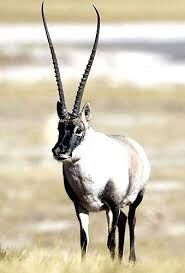Tibetan antelope | Animalia Kingdom
The Tibetan antelope or chirú (Pantholops hodgsonii) is a species of artiodactyl mammal of the subfamily Antilopinae of medium size indigenous to the Tibetan highlands, northern India and certain regions of Nepal and central China.
One of the beautiful fuwa, the mascots of the 2008 Beijing Olympics, is a beautiful Tibetan antelope named YingYing, symbolizing health.
Location and characteristics
It is an endemic species of the Tibetan plateau: it can be found in alpine steppes between 3,200 and 5500 meters above sea level. It likes open terrain and sparse vegetation, which is why it can also be found in northern India and in certain regions of China and Nepal.
Its scientific name is Pantholops Hodgsonii and it belongs to the antelope family. Medium in size, males can reach 85 centimeters in height and weigh about 40 kilos (females are 10 centimeters smaller and almost 15 kilos lighter).
In this species there is a marked sexual dimorphism, since the male specimens also have horns and black lines on the legs. The antlers are curved back and can reach 60 centimeters and, unlike goats, they do not grow for life. Males use their horns to show power in the breeding months.
In both sexes the coat is reddish brown with a thick, woolly white belly. The face is almost completely black and, during the winter season, in males it is more marked, since their body becomes paler.
Behavior and reproduction of the Tibetan antelope
As for its diet, the Tibetan antelope bases its diet on grasslands, grasses and reeds. In winter he must dig in the snow to get food, as it is quite scarce.
It is a gregarious animal, which means that it gathers in herds of hundreds of specimens when moving from one side to the other in search of better pastures to eat. But, generally, it forms smaller groups, of about 20 individuals.
They are very shy and fast animals, they can reach 80km / h when they escape from a predator, mostly wolves, lynxes, snow leopards and red foxes.
Females can walk up to 300 kilometers per year to give birth, while moving away from the group and the males. They then rejoin the herd in late fall.
Regarding their reproduction, the mating season is from November to December. Each male forms a ‘harem’ of a maximum of 12 females – four is usually the usual number of ‘concubines’ – and is responsible for expelling the other males, through certain ‘displays’ with his head.
Ultimately, the males use the horns to demonstrate their might. For example, if another specimen is too insistent and stays in the harem area.
Females give birth to only one calf per litter. The delivery occurs between June and July, since the gestation lasts approximately six months. Babies can get up on all fours at 15 minutes after birth and stay next to the mother for a year (males) or a year and a half (females).
In the second or third year of life they reach sexual maturity. Although it is not known how many years they live, it is estimated that they can survive for 10 years.
Status of the Tibetan antelope
The ‘highland goblin’, as it is affectionately called by the local population, is a protected species in China and there are even three nature reserves that aim to conserve it.
The number of specimens declined in the 1990s due to poaching – antelope wool is valued for its ability to shelter in harsh winter – and the lack of food, since more and more must hide from humans.
For this reason, the Chinese government has taken action and, thanks to the help of volunteers, little by little the population of the Tibetan antelope is increasing. Even the species is no longer endangered: it is currently listed as ‘near threatened’.



